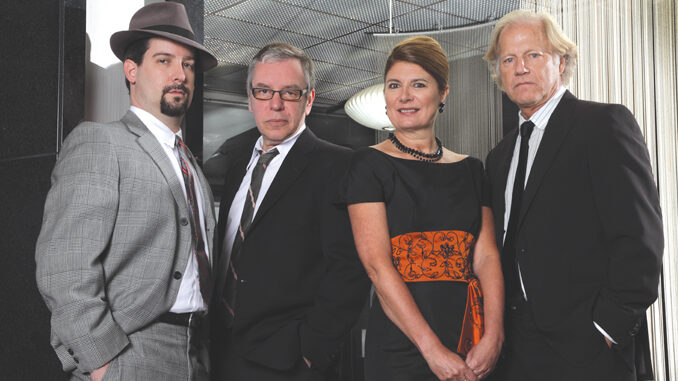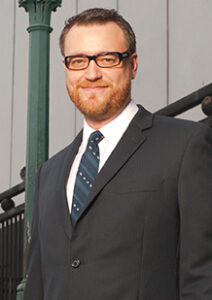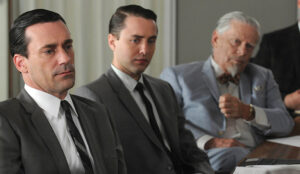
by Garrett Gilchrist
Created by former Sopranos writer Matthew Weiner, AMC’s acclaimed Mad Men unveils the curiously alluring world of Don Draper, a top New York advertising man in the 1960s who has built his life around a series of lies.
Nominated for 49 Emmys, and collecting 13, Mad Men has won both Outstanding Drama Series at the Emmy Awards and Best Television Series – Drama at the Golden Globes for the last three years in a row. As the fourth season was winding down, Editors Guild Magazine spoke with several of the show’s editors.
“So much of the most exciting, important work is happening on television,” says Malcolm Jamieson, who edited episodes during Mad Men’s first three seasons, but this season has been working on HBO’s Treme and a feature for director Joshua Marston.
”I hadn’t done any TV of that nature, but they were looking for a feature-style editor, and I came from the world of independent features.” Jamieson had worked previously with Alan Taylor, who directed the Mad Men pilot. “Alan gave me a chance I would- n’t have gotten elsewhere, and I eventually won Matt over,” he says.
“Everybody knew, right from the beginning, that this show was huge,” Jamieson claims. “It was going to take the world a little while to catch up with it, but we knew how special it was. Matt’s voice and vision were so clear and focused right from the beginning. That fueled the work. It was a period piece, but it felt completely new.

“The greatest truth about the show is that it’s about lies,” he continues. “That was the most challenging and enjoyable part for me, seeing the little flickers in the characters’ eyes as they struggle with telling an untruth. To a certain extent, society celebrates the lie. Matt doesn’t celebrate that, but exposes it to be completely human.”
“Mad Men is classically shot and classically cut, and I really like that,” says Leo Trombetta, A.C.E., who edited two episodes for the first season and was happy to return for Season 4. “I’m a fan of films from the ‘50s and the early ‘60s. There are certain limitations to what you can do as an editor, but I find that strangely liberating. It’s a challenge to work within those rules.
“There’s that tendency now to cut things really quickly and have a lot of gratuitous camera moves,” he continues. “You couldn’t imagine Mad Men with jump cuts, split screens or a lot of CGI; it wouldn’t feel like the period. We rarely even use dissolves. We spend hours laboring over every cut so that the editing doesn’t draw attention to itself. You take a certain pride in the fact that no one will ever notice what you did.”
‘Throw It Away’
Jamieson concurs: “Matt’s mantra is ‘throw it away.’ Don’t embellish it. Let the writing speak for itself. It makes you pay attention more. The Sopranos had a huge influence, even on network shows, which did a great service to us all. We can stay in a shot longer. Viewers can be patient with the unfolding storylines. We’re never forced to cut up a scene to pick up the pace––unless that was Matt’s intention.”
“It’s great that we can linger,” agrees Christopher Nelson, A.C.E., who has been editing Mad Men episodes since the first season, but departed halfway through the fourth season and is currently working on Undercovers for J.J. Abrams. “You engage by being drawn into the characters, and feeling what they’re feeling, or wondering what they’re feeling. Don Draper doesn’t reveal much of what’s going on inside of him––and as an audience it makes us want to know.”
Says Trombetta, “Matt writes or rewrites every word of the scripts, including the stage directions. He understands every detail––down to what the characters are doing with their hands. He has such a precise vision that the first screening is always a bit traumatic for him. It has been interpreted by the actors and the director, and it has been subject to time constraints and budget limitations, so it takes a little adjusting.”
Tom Wilson began as Jamieson’s assistant editor. During Mad Men’s second sea- son, he was promoted to editor. “With so much of our story being sub-textual, sometimes things just don’t get done the way that Matt had in mind when he wrote it,” Wilson offers. “He will say, ‘The next time I watch this scene, I’d like to feel this; I’d like to think this about this character.’ And he’ll let us go. We have a lot of creative input to do whatever we need to in order to evoke that emotion.”
According to Nelson, “Sometimes you can get to what Matt imagined; sometimes you can’t. And sometimes there’s a completely different solution from either what was shot or what was conceived.”
Jamieson elaborates: “Matt won’t tell you, ‘Make those five cuts; fix it.’ He’ll get you inside that scene. He wants you to understand it. I suppose I’m a method editor. I’ll get grumpy or depressed, to go through that emotional experience, putting it into perspective. I always understood why the characters did what they did. Maybe I’ve told that lie too. That’s very challenging stuff.”
Each episode of Mad Men is finished about two weeks before transmission. The editors will go through four to six edits of an episode with Weiner after the director’s cut is finished. “Every episode I’ve worked on has generally been several minutes over,” says Trombetta.
“That’s partly done on purpose,” adds Wilson. “Matt will overwrite certain scenes to help the actors get from point A to point C. We’ll cut out point B later, but you’ll see that natural progression, performance-wise.”
Running Time Challenges
Getting the show down to its 47-minute running time is always a struggle, accord- ing to Jamieson. “We’ve lost a few scenes, but not as many as you’d think. It’s a cliché, but we get in late and get out early. We cut entrances and exits and introductions. The hard work is making significant trims in dialogue in a way that looks like nothing was lost.”

Overseeing the team is the producer in charge of post-production, Blake McCormick. “He’s our rock,” says Wilson. “He’s the core we’re all attached to. Without Blake, things would rapidly fall apart. He has an incredibly difficult job, keeping up with a schedule that is changing several times a day. Matt is involved in every aspect of the show, and he’s always being pulled in a hundred different directions at once. Blake manages to keep everything spinning around the proper axis. He never gets enough credit for what he does.”
As an editor on the show, Jamieson says he was never trying to satisfy the network. “They’ve been great and supportive, but we’re editing for an audience of one––Matthew Weiner,” he explains. That’s the only way to work on this show; there’s one vision that counts. It’s a credit to companies like AMC, HBO and Showtime that they are letting smart people make the shows their own way. That’s just priceless. They could have demanded a more commercial approach, but I don’t think it would have been as good a show. I think it’s a success because it has clarity. It respects the audience — and people appreciate that.”
Mad Men respects its crew too. “I’ve worked on a lot of shows where the assistants were treated as insignificant,” says Pattye Rogers, who joined the show as an assistant editor in Season 3 and edited two episodes in Season 4. “But here, the assistants are really involved in the process. It’s a great place to work––very collaborative. Matt wants your input and wants to know what you thought of the script. The producers are very editor-friendly. It does get hectic toward the end of the season, but if we need more time to get it right, they understand that.
“I also think the show is very pro- women,” she adds. “They have to work within a man’s world, but the women characters are all smart and strong––and that’s very positive.”
“People are people,” says Wilson. “They will behave the same, no matter what era, or what situation they’re placed in. Matt is an excellent judge of human behavior. Every line of dialogue means three things and every glance means something important. It’s all about emotion. We work on it until we feel everything we want the audience to feel.”
Invisible Effects
“Matt is really concerned that the viewer hears everything, and understands what’s being said,” says Trombetta. “He wants to see as much of the dialogue onscreen as possible, not off-screen or on someone’s back. That’s not always the easiest thing to do. We use a lot of invisible effects. I’ve edited scenes where the left half of the screen is from one take, and the right half is from another take, because the performance was distracting on the right side.”
The show’s pace, according to Rogers, lets them depict both sides of a conversation. “You see the character’s process,” she says. “You see him finish his line, and you see the other character react before saying her line. So many shows these days are just cut line, line, line––without time for that emotion.”
“You take a certain pride in the fact that no one will ever notice what you did.” – Leo Trombetta
That seemingly simple pacing decision often requires a special effect. “There are very few isolated single close-ups in the show,” says Nelson. “It’s over the shoulder, or slightly wider. So you’ll sometimes see the other actor’s head start to move at the end of a line, as he anticipates starting to speak. We started doing split screens to hide that.”
Another favorite tool is Media Composer’s Fluid Morph. “On any other show, if an actor is pausing for too long, we’d cut to the other actor for a reaction, and pull that pause out,” says Nelson. “But Matt doesn’t want to play lines offstage. Instead, if a pause is too long, we morph from one frame to another to cover the time seamlessly. Usually it’s invisible, and you’d never know.” Jamieson adds, “I can’t do that on other shows, because the camerawork is usually looser. But because Mad Men has clean, stable camerawork, we’re in a much better position.”
“Editing software has really caught up with our needs,” says Wilson. “We have yesterday’s HD dailies delivered on a drive every morning and work in HD until we finish. The Avid Nitris systems are amazing. It’s all gorgeous, top-of-the-line equipment.”
The team is also quick to praise composer David Carbonara, even though most scenes play without music. Says Trombetta, “It’s Matt’s decision to not manipulate the audience with music. We use music if the scene would feel strange with- out it. If a moment can play without music, we usually leave it out. We want the emotions to be earned. Inalotof shows, music is used because the drama doesn’t work without it. You can amp up the emotions with music, but that’s a cheat––are you responding to the story or to the music?”
“David likes to be invisible,” says Jamieson. “You shouldn’t realize you’ve heard music. He does a beautiful job of allowing the character and the audience to be in an emotional space before realizing that music has come in underneath to sup- port it. The music is never judgmental. It doesn’t comment on a scene that’s happening. It echoes and emphasizes what you’re feeling as an audience member.”

Each episode is shot in eight days. “I generally have a couple days to put together my first assembly, then the director has four days for his director’s cut,” explains Trombetta. “When Matt comes in, that’s when the real work begins. The schedule is based on how much time Matt has, because he oversees everything––casting, hair, makeup, costumes, props, production design, etc. Toward the end, it’s really crunch time, where you put in very long hours, but for the most part it’s pretty comfortable. Nobody works harder than Matt.”
Nelson says he identifies with Mad Men’s morally ambiguous lead character Don Draper in a way. “Don does leave a wide swath of destruction behind him,” he says. “But he’s not a bad guy. He’s searching, trying to fill a void inside him. He almost does nothing with malice. On some level, he feels he’s a total fraud and doesn’t want anyone to find out. His insecurities and fears are probably the engine that drives him. We all have that self-doubt––unless we’re delusional,” he says. “It takes someone else to say that what we’re doing is any good for us to believe it.
“However, as soon as you fall in love with your work, you’ve ceased to be able to make it better,” continues Nelson. “I’ve known editors who are too happy with their work, and resist changing things. You might get a note, particularly from the studio or the network, and you think, ‘I don’t understand that. I don’t agree with that.’ But they’re saying that because something is bothering them. It’s feeling false, and they’re giving you a note to try to find a solution––any solution. You have to stop and analyze what it’s really about.”
“I always take it as a compliment when people say the show doesn’t look that hard to cut together,” concludes Wilson. “I’m glad we’re able to make hard work look so effortless. There’s a level of excellence that’s demanded, and we’re all on board with that. We’re willing to work over weekends and holidays until it’s right. This is a rare show; one that comes along once every 20 years. We’re very aware how fortunate we are––and we’re thankful to be a part of it.”






